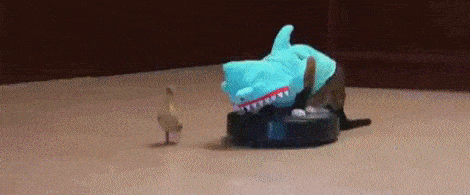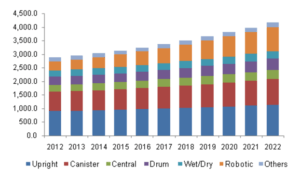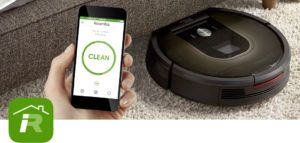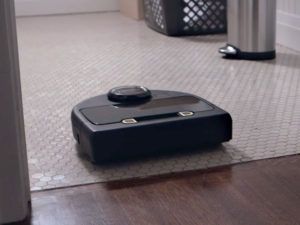iRobot’s Roomba: Vacuuming the floor with the competition

The Roomba revolutionized the vacuum cleaner industry. But can it continue to outpace its competitors?
Technological innovation has allowed mankind to accomplish incredible feats over the past few decades: we’ve put a man on the moon, made communication between distant parts of the world nearly instantaneous, and developed medical imaging machines which allow doctors to accurately diagnose patients without performing surgery.
We’ve also made a robot that can vacuum those Cheetos you spilled under your couch three weeks ago.
iRobot—the market leader in household robotics—began its journey in the defense contracting industry. The company’s devices have included landmine-detection robots, bomb-disposal robots, and robots designed to carry heavy loads for small, dismounted groups of soldiers.[1] However, iRobot became a household name in 2002 when it embarked into the consumer products realm with its release of the “Roomba,” a small, disc-shaped machine which could autonomously vacuum a prescribed area. iRobot has since broadened its product portfolio with robot mops, gutter cleaners, and pool cleaners.
Over the past fourteen years, iRobot has progressively gained market share over more established, “conventional” vacuum brands like Hoover, Dyson, and Black & Decker. As a segment, robotic cleaners (also known as “robovacs”) are expected to grow at a CAGR of 11.4% to 2022 in the United States.[2] Worldwide, robovacs command 20% of the vacuum market—of which 70% is controlled by iRobot.
Despite this tremendous performance, growth has been somewhat restricted by the high price of a robovac: most products are priced well above $500,[4] although iRobot recently developed a $274 vacuum with an impressive range of capabilities (automatic cleaning, docking/recharging, and adjustment for floor types). iRobot competes well with high-priced vacuums (i.e. Dyson), but so far fails to provide an alternative to its lower-priced competitors. For example, most of Hoover’s vacuum cleaners are priced below $200.[5]
iRobot is well-positioned to continue to lead the robovac category, which has recently become its sole focus. In early 2016, it “divested itself of its defense and security robotics division and is now focused entirely on the home consumer space.”[6] To continue to gain market share over its conventional competitors, it must focus on two things: 1) lowering its entry-level price point, and 2) be the first robovac manufacturer to fully capitalize on the internet of things (IoT). For this post, I’ll focus primarily on the latter.
iRobot has already started to entrench itself into the IoT, but must continue to pursue new technologies. Its newest Roomba can be controlled via smartphone—but Colin Angle, iRobot’s CEO, has much more in mind. He envisions a robotic vacuum which continuously its environment and assesses potential threats (i.e. robbers), monitors temperature (and link to smoke alarms in case of fire), and much more.[8] To stay relevant, iRobot must be the first business to incorporate these functions into its devices at a reasonable price. At the moment, the smartphone-controlled Roomba sells for almost $800.
In addition, Roomba should listen to its customers and work more with other IoT companies. For example, there is no way to connect the Roomba and Amazon’s Echo to date. It’s necessary for iRobot to stay on the cutting edge of technology in the consumer space, as the market is quickly becoming crowded. A similar product, Neato’s Botvac, provides most of the same functionality (including smartphone connectivity) at a lower price.[9] iRobot risks losing its competitive advantage if it fails to innovate ahead of its competitors.
Ultimately, the future of iRobot is bright—provided the company continues to integrate into the IoT and lowers its entry-level price point. Given the company’s steady track record of success, it seems likely that iRobot will continue to succeed. The free press can’t hurt, either: a video of a cat riding a Roomba has over 11 million views on YouTube.[11]
800 words
Photo Source: YouTube.com. 2012. Cat In A Shark Costume Chases A Duck While Riding A Roomba. [ONLINE] Available at: https://www.youtube.com/watch?v=Of2HU3LGdbo. [Accessed 18 November 2016].
[1] Ron Amadeo. 2016. iRobot sells off military unit, will stick to friendlier consumer robots. [ONLINE] Available at: http://arstechnica.com/gadgets/2016/02/irobot-sells-off-military-unit-will-stick-to-friendlier-consumer-robots/. [Accessed 18 November 2016].
[2] Grand View Research. 2016. Household Vacuum Cleaners Market Analysis By Product (Upright, Canister, Central, Robotic, Drum, Wet/dry), And Segment Forecasts To 2022. [ONLINE] Available at: http://www.grandviewresearch.com/industry-analysis/household-vacuum-cleaners-market. [Accessed 18 November 2016].
[3] Ibid.
[4] Vipassa Kakroo. 2015. Residential robotic vacuum cleaner market poised for stellar growth. [ONLINE] Available at: http://robohub.org/residential-robotic-vacuum-cleaner-market-poised-for-stellar-growth/. [Accessed 18 November 2016].
[5] Amazon.com. 2016. Hoover BH52210PC Cruise Cordless 22V Lithium Ion Lightweight Stick & Vacuum Cleaner. [ONLINE] Available at: https://www.amazon.com/Hoover-BH52210PC-Cordless-Lithium-Lightweight/dp/B01KKCI9GE/ref=sr_1_10?ie=UTF8&qid=1479496954&sr=8-10&keywords=hoover. [Accessed 18 November 2016].
[6] Darrell Etherington. 2016. iRobot says 20 percent of the world’s vacuums are now robots. [ONLINE] Available at: https://techcrunch.com/2016/11/07/irobot-says-20-percent-of-the-worlds-vacuums-are-now-robots/. [Accessed 18 November 2016].
[7] iRobot.com. 2016. Download the iRobot HOME App. [ONLINE] Available at: http://www.irobot.com/For-the-Home/App/Download.aspx. [Accessed 18 November 2016].
[8] Meghan Ottolini. 2016. iRobot CEO: Robotics Is An IoT Solution. [ONLINE] Available at: http://www.crn.com/news/internet-of-things/video/300081385/irobot-ceo-robotics-is-an-iot-solution.htm. [Accessed 18 November 2016].
[9] Christian de Looper. 2015. The Neato Botvac Is A Connected Vacuum That Can Be Controlled With A Smartphone. [ONLINE] Available at: http://www.techtimes.com/articles/81548/20150902/neato-botvac-connected-vacuum-controlled-smartphone.htm. [Accessed 18 November 2016].
[10] Ibid.
[11] YouTube.com. 2013. Cat Wearing A Shark Costume Cleans The Kitchen On A Roomba. Shark Week. #SharkCat cleaning Kitchen!. [ONLINE] Available at: https://www.youtube.com/watch?v=tLt5rBfNucc. [Accessed 18 November 2016].






Great post! I personally don’t have an iRobot but would love one when I occupy a large enough house. And, when I do, I’d love to sync it up with my Amazon Echo. However, given Amazon’s history of product line expansion and its Lab126 division, I would be somewhat surprised if Amazon were willing to partner with iRobot on providing a seamless experience for IoT products in the home, especially given Google’s acquisition of Nest. I would also be curious to learn more about whether there are any privacy concerns with iRobot’s products. For instance, the Roomba contains a low-fi camera that collects information about the layout of the house, which it then uses as a map when it vacuums the house. If not managed properly, this could be very concerning for the privacy-conscious consumers.
I have been obsessed with iRobot since they released the original Roomba. I agree with your thesis that iRobot will need to innovate new features for the Roomba in order to stay relevant. I’m curious however if this will be new features on the actual Roomba or if it means introducing complimentary products. Nest has been gaining a lot of ground in introducing “smart-home” products at a reasonable price. I wonder if the move for iRobot will be to introduce products which compete with the Nest products but with the kicker that the products will integrate with the Roomba as well. As you mentioned however, in order for them to compete in this space their entry price point will need to drop considerably.
This is a very interesting article. I didn’t know that iRobot had its foundations with DOD-related applications. I’m surprised to see that they divested this category. What made them do this?
In the world of consumer electronics, I agree that IoT integration is a nice achievement for products. I thought partnering with Google to integrate with Nest might provide some value to consumers. However, what would an IoT-connected Roomba be able to do that programs such as Nest are unable to do? Furthermore, I worry that given the new Roomba 980 model (Wi-Fi enabled) with a low-resolution camera, issues surrounding security arise. Given the Wi-Fi, a theoretical hacker could be able to access to the camera remotely without the owner knowing.
Overall, it appears that pursuing the IoT is a main objective of the company. According to the CEO, Colin Angle in the article below, the company intends to drive into the category by working with smart lighting and room mapping.
http://fortune.com/2015/10/06/roomba-980-review/
This post really swept me off my feet! A vacuum cleaning robot? What will those creative scientists come up with next?!
What is iRobots competition? Are the traditional vacuum manufacturers starting to produce their own robotic vacuums? It seems to me that the Roomba is a niche product. I don’t think the little, friendly disks really compete with traditional upright vacuums in terms of power or reliability. I could be wrong, but that is certainly the perception I have.
In terms of IoT, I think the Roomba and the iRobot company are probably facing the same issues other companies in the field are facing. They simply don’t know what to do with an internet connected vacuum. They can do all sorts of things with an internet connected device (they could stream Netflix to it) but finding what customers would value or find useful is really, really difficult.
Regardless, a vacuum cleaning robot is the type of innovation that America needs, especially in this economy.
Very interesting!
I actually interviewed for iRobot back in 2012 as an engineer and was not very excited about them because I thought they were just a vacuum company! That was definitely before companies started dreaming of IoT. I really liked your last point – I think competition/integration with other products is going to be huge. I wonder if this is just going to call for more M&As in the tech industry…
Interesting to see the expected growth for this segment. I have personally never viewed the Roomba as a practical purchase for the general home owner or resident – but it looks like there is a substantial market for it. As some of our brilliant section-mates have already mentioned I worry about the issue of cyber security especially as iRobot begins to integrate their products with the internet of things. Even today we see people worried about the idle cameras on their stationary laptops – covering them with stickers or tape to ensure that no one is spying on them. Similarly, I wonder how people will feel about the camera on their vacuum that is connected to the internet and also has the ability to move around their home. However, I do believe that overall the value proposition here is solid. There is no denying that people seek additional convenience in their lives. I wonder when we will see similar technology spill over into the home gardening and lawn care – or even agriculture. Do similar technologies exist in these spaces already?
That GIF is amazing and leads me to think that in addition to the convenience factor of a Roomba there is also a subtle entertainment factor. Partnerships and integration do seem critical to the Roomba’s success especially in the broader context of the connected home. I wonder if iRobot has thought about expanding outside of vacuums? My guess would be that if they could diversify their product mix and have them run off of one central app, they would be better positioned in the market because they could create a captive audience off of the app. I also wonder if the integration with Echo actually benefits Amazon more than iRobot because it allows the Echo to become the central point of control (I’m guessing the Echo also integrates with other devices such as Nest, Ring). As a result, Echo gets the secondary product benefits and positions itself in a new way, as the central remote control for the home.